Malignancy-Associated Hypercalcemia and Medical Management
The History of Malignancy-Associated Hypercalcemia
Malignancy is the second most common cause of hypercalcemia in the general population and by far the most common cause among inpatients. Hypercalcemia was first reported in patients with cancer in the 1920s.1 The first large series of patients with malignancy-associated hypercalcemia (MAHC) was reported in 1936 by Gutman and colleagues.2 This group of patients primarily had multiple myeloma and breast cancer; skeletal invasion by tumor was extensive radiologically. The authors inferred that the cause of hypercalcemia in these patients was skeletal invasion by the malignancy.
This mechanism was assumed to be operative in all instances of MAHC until 1941, when Albright3 described a hypercalcemic patient with renal carcinoma and a solitary skeletal metastasis. He reasoned that a single bone metastasis was inadequate to cause hypercalcemia. Furthermore, he noted that the patient was hypophosphatemic, not hyperphosphatemic, as would be expected from the combination of rapid dissolution of skeletal phosphate-containing hydroxyapatite and parathyroid suppression induced by the hypercalcemia. Albright suggested that the hypercalcemia in this patient was etiologically distinct from that in the previously described patients with breast cancer and multiple myeloma and proposed that hypercalcemia resulted from secretion by the renal carcinoma of parathyroid hormone (PTH) or another humoral factor that resembled PTH. Support for Albright’s humoral hypothesis was presented in 1956, when two groups reported that surgical or other eradication of tumor reversed hypercalcemia in patients with carcinoma unaccompanied by skeletal involvement.4,5 After additional reports supporting the “humoral hypothesis,” Lafferty6 in 1966 reviewed 50 patients with humorally mediated hypercalcemia. By definition, these patients had no detectable skeletal metastases on radiographs or manifested disappearance of the hypercalcemia with tumor ablation or both. Histologically, the patients proved to have predominantly squamous (particularly lung), renal, bladder, and gynecologic malignancies.
Thus, by the end of the 1960s, two broad mechanistic categories of MAHC had clearly been demonstrated.7–9 In one group of patients, hypercalcemia develops through skeletal invasion and destruction by tumor, a condition we have referred to as local osteolytic hypercalcemia (LOH)2,7–10 (Table 8-1). In the other group of patients, hypercalcemia develops predominantly through a humoral mechanism, a condition we have referred to as humoral hypercalcemia of malignancy (HHM).11–13 Subsequently, two additional mechanistic subtypes were well described. These include authentic ectopic hyperparathyroidism and 1,25(OH)2-vitamin D–induced hypercalcemia in patients with lymphomas. These four types are summarized in Table 8-1 and are discussed in detail later.
Table 8-1
Tumor Histology in Malignancy-Associated Hypercalcemia
Tumors COMMONLY Associated With Local Osteolytic Hypercalcemia
Tumors COMMONLY Associated With Humoral Hypercalcemia of Malignancy
Squamous carcinoma (lung, head and neck, esophagus, cervix, vulva, skin)
Endocrine tumors (pheochromocytoma, adrenocortical carcinoma, islet carcinoma, carcinoids)
Tumors Associated With 1,25(OH)2D Overproduction
Tumors Associated With Authentic Ectopic PTH Secretion
Common Tumors Rarely Associated With Hypercalcemia
*Has been reported with many different histologic types of lymphoma.
Clinical Features of Malignancy-Associated Hypercalcemia
Hypercalcemia occurring in a patient with cancer indicates that the overall prognosis for the patient in question is very poor. For example, in a study by Ralson and collaborators,14 the onset of hypercalcemia was associated with a 30-day survival rate of only 50%.
The clinical manifestations of the hypercalcemia that accompanies cancer are no different from those that accompany other hypercalcemic disorders. Polyuria, polydipsia, dehydration, renal compromise, constipation, and varying degrees of neurologic dysfunction ranging from lethargy or confusion to coma are common. The electrocardiogram may show shortening of the QTc interval.15,16 The correlation between the degree of hypercalcemia and a given patient’s neurologic function is poor. Other factors (such as the rate of development of hypercalcemia, the presence of underlying central nervous system dysfunction, the presence of other metabolic disorders, and the use of a variety of medications) may profoundly influence the effects of a given degree of hypercalcemia. Patients with skeletal metastases may report skeletal pain or pathologic fractures or both. Sometimes the onset of hypercalcemia can be ascribed to factors other than tumor progression (e.g., recent immobilization, addition of a thiazide diuretic, prerenal or renal azotemia leading to inadequate renal calcium clearance, hypophosphatemia resulting from inadequate oral intake, gastrointestinal fluid losses, medications, parenteral calcium administration in the form of hyperalimentation). These events should be specifically sought because their correction may reverse a given patient’s hypercalcemia.
No study has precisely defined the relation of tumor size to the presence or absence of hypercalcemia. Nonetheless, to the extent that tumor size has been studied, it would seem clear that small, occult tumors rarely cause MAHC.2–12,17,18 A corollary of this statement is that when a patient has MAHC, the tumor that is responsible usually is readily apparent after only a modestly rigorous search; conversely, if a tumor has not been found after 2 or 3 days of evaluation in a hospitalized, hypercalcemic patient, it is unlikely that a malignancy is the cause of the hypercalcemia. Thus, a careful history and physical examination with attention to the skin, oropharynx, esophagus, pulmonary system, liver, genitourinary tract, hematopoietic system, and breasts and a limited laboratory and radiologic investigation focused on the hematologic system, esophagus, kidneys, bladder, gynecologic structures, and skeleton will almost invariably lead to rapid definition of the responsible tumor. Occasionally, retroperitoneal tumors (renal carcinomas, lymphomas, pancreatic tumors) may be difficult to demonstrate. Finally, endocrine tumors (e.g., islet carcinomas, pheochromocytomas, ovarian carcinoids) may lead to hypercalcemia and yet may be small and difficult or impossible to localize.
In approaching the evaluation and treatment of a patient with hypercalcemia and cancer, it is important to bear in mind that hypercalcemia may occur in patients with cancer for all the same reasons that it occurs in patients without cancer. For example, in a series of 133 patients with cancer and hypercalcemia encountered between 1978 and 1984, we identified 8 patients with cancer in whom hypercalcemia ultimately proved to result not from cancer but from coexisting primary hyperparathyroidism.12 Similarly, we have observed hypercalcemia resulting from tuberculosis, sarcoidosis, immobilization, vitamin D intoxication, hyperthyroidism, thiazide use, Addison’s disease, and other causes in patients initially perceived as having MAHC. Thus, the entire differential diagnosis of hypercalcemia should be entertained in every patient in whom hypercalcemia is identified, even if it appears at the outset that cancer will prove to be the ultimate cause. This approach is particularly important for the following reasons: (1) in contrast to the poor ultimate prognosis in MAHC, most causes of hypercalcemia other than cancer are readily treatable; (2) identifying a treatable, nonmalignant cause of hypercalcemia in a patient with cancer may dramatically change the overall perception of a case by the patient’s physicians; and (3) treatment approaches may vary.
It is important to say a word about the tumor histologies associated with hypercalcemia (see Table 8-1). Virtually all tumor types have been reported to cause hypercalcemia, but, as will be described in the sections on LOH and HHM, certain tumor types are particularly common causes of hypercalcemia. Conversely, certain other common tumor types (prostate, colon, oat cell, thyroid, and gastric carcinomas, and primary central nervous system malignancies are examples) almost never cause hypercalcemia2–12,17,18 (see Table 8-1). When these tumors are identified in a patient with hypercalcemia, other tumors or other nonmalignant causes of hypercalcemia should be sought.
Local Osteolytic Hypercalcemia
Hypercalcemia can result from direct skeletal involvement by a primary hematologic neoplasm or by skeletal metastases from a nonhematologic neoplasm. Patients with LOH account for approximately 20% of patients in a series of patients with MAHC.2–12,17–22 The malignancies that most commonly lead to LOH are multiple myeloma, leukemia, lymphoma, and breast cancer2–12,17–22 (see Table 8-1). This list is not exhaustive, for many other tumor types occasionally have been reported to cause hypercalcemia through skeletal metastasis.2–12,17–22
Hypercalcemia that occurs in patients with multiple myeloma and breast cancer was initially attributed to the direct physical destruction of bone by malignant cells. This concept is now seen as naive, for it is clear that simply having malignant tumor cells in the bone marrow compartment is insufficient to cause hypercalcemia. First, bone resorption surrounding malignant cells in bone marrow is always accomplished by osteoclasts, not tumor cells, indicating that osteoclast recruitment and activation by tumors are required. Second, although some tumor metastases in bone are commonly associated with LOH (breast cancer and myeloma are examples), certain other tumor types typically associated with destructive skeletal metastases (e.g., small cell and prostate carcinomas)23,24 only rarely cause hypercalcemia. Moreover, one large study reported an inverse correlation between the number of bone metastases and the serum calcium concentration in a series of hypercalcemic patients with breast cancer.25 Thus, the pathophysiology of the hypercalcemia in LOH is based on paracrine factors or cytokines that are capable of activating osteoclasts, and these are produced by only certain types of malignant cells in the bone marrow. It is these factors that produce hypercalcemia in LOH.
A search for these so-called osteoclast-activating factors, or OAFs, began in the 1970s with reports by Mundy and others26,27 that short-term cultures of bone marrow aspirates from patients with myeloma or lymphoma contain a bone-resorbing factor or family of bone-resorbing factors that are capable of stimulating osteoclasts in vitro. Despite work over the past four decades, the precise array of cytokines that compose OAFs remains incompletely resolved. At the time of this writing, the most attractive candidates include receptor activator of nuclear factor (NF)-κB ligand (RANK-L), macrophage inflammatory protein-1α (MIP-1α), interleukin-1α, interleukin-6, parathyroid hormone–related protein (PTHrP, see later), and tumor necrosis factor-α (TNF-α).28–31 In patients with lymphoma, studies by Dewhirst and others30 have suggested a role for interleukin-1. Thus, it seems likely that the generic term, OAF, actually constitutes a group of such factors that can mediate hypercalcemia in a tumor-specific fashion.
The discovery and elucidation of the RANK-RANK-L system in the late 1990s provided a particularly exciting advance and recently has been reviewed in detail as it relates to bone metastasis and myeloma.31,32 In brief, osteoclast precursors (macrophages) and mature osteoclasts express the receptor, RANK. Osteoblasts and marrow stromal cells normally express the ligand (RANK-L) and upregulate RANK-L in response to agents that recruit osteoclast precursors and induce them to form osteoclasts and initiate and enhance bone resorption. Thus, for example, PTH and PTHrP act via the PTH receptor on marrow stromal cells and osteoblasts and induce them to produce more RANK-L. This then stimulates osteoclast precursors to form more osteoclasts and induces mature osteoclasts to become more active as well. It is interesting to note that osteoblasts and marrow stromal cells also produce a soluble or secreted decoy RANK receptor called osteoprotegerin (OPG). OPG serves to balance the bone resorption induced by the RANK-RANK-L pathway. Increases in OPG production by marrow stromal cells and osteoblasts can completely prevent osteoclast recruitment and bone resorption. Thus, osteoclast number and activity ultimately depend on the balance between OPG and RANK-L in the marrow microenvironment. This, in turn, depends on how much OPG and RANK-L are produced by marrow stromal cells and osteoblasts, and, in the case of skeletal metastases or myeloma cells, whether they activate or serve as surrogates for the native RANK-RANK-L system. To be more specific, credible evidence now suggests that myeloma cells themselves may produce large amounts of RANK-L, and, through direct interaction with RANK on osteoclast precursors, may activate osteoclast recruitment and further activate bone resorption, leading to the massive osteolysis characteristic of multiple myeloma.28,31 These observations have not only pathophysiologic implications but potentially therapeutic ones as well, as is discussed later.
Another characteristic feature of myeloma bone disease is that bone formation by osteoblasts is absent. Thus, the skeletal demineralization of myeloma can be seen as being due in part to dramatic increases in bone resorption, as described earlier, acting in concert with dramatic reductions in osteoblastic bore formation. This marked uncoupling of bone formation from resorption is not well understood, but it is believed that cytokines or other paracrine factors produced by malignant plasma cells may be responsible for this suppression of bone formation in myeloma. In support of this possibility, Tian and colleagues33 recently reported that myeloma cells greatly overproduce DKK-1, an antagonist of the wnt signaling pathway that is known to be critical for osteoblast function. More recently, the Roodman group34 has reported that interleukin-3 (IL-3) secreted by malignant plasma cells can also act to suppress bone formation. DKK and IL-3 findings also suggest novel therapeutic strategies for inducing bone formation in patients with myeloma. It is possible that the marked infiltration of malignant plasma cells characteristic of myeloma replaces marrow stromal cells that might otherwise serve as a source of osteoblast precursors, and this lack of osteoblast precursors thus results in inadequate bone formation.
Progress also has been made in our understanding of the cellular mechanisms responsible for bone resorption by skeletal metastasis in breast cancer. An increasing number of reports suggest a role for PTHrP as a local or intraskeletal mediator of osteoclast activation in women with breast cancer bone metastases.29,35–38 Immunohistochemical analysis by Southby and associates37 demonstrated that 12 (92%) of 13 breast cancer skeletal metastases contained PTHrP, whereas only 3 (17%) of 18 nonskeletal breast cancer metastases contained PTHrP. These findings have been confirmed at the in situ hybridization level for PTHrP messenger RNA (mRNA) in breast cancers metastatic to bone or soft tissue.38 In addition to suggesting a role for PTHrP as a local bone-resorbing factor, these studies suggest that PTHrP somehow may serve to favor metastasis to the skeleton, as well as tumor growth, in patients with breast cancer. Guise and collaborators36 showed this concept to be true: In human breast cancer cell lines bioengineered to express PTHrP at high or low levels, those producing large quantities of PTHrP were more likely to lead to bone metastasis than were those expressing low levels. Moreover, after the development of bone metastases, a local skeletal vicious cycle appeared to develop in which PTHrP induces osteoclastic bone resorption, which in turn leads to the local release of TGF-β from resorbed bone. This locally released TGF-β further induces tumor-derived PTHrP production and accelerated bone resorption.36
Hypercalcemia will develop in approximately one third of women with breast cancer and bone metastases treated with estrogen or antiestrogens such as tamoxifen.39,40 The mechanisms responsible for this “estrogen flare” in breast cancer remain undefined. Frequently, the hypercalcemia will resolve spontaneously if hypercalcemia can be controlled over the short term and endocrine therapy can be continued.40 It has been suggested that the tamoxifen-induced hypercalcemic flare predicts a favorable tumor response. Valentin-Opran and colleagues41 suggested, after work with cultured breast cancer cell lines, that estrogen exposure enhances the production of undefined bone-resorbing factors.
From a clinical and biochemical standpoint, LOH is associated with accelerated bone resorption11–13,35,42 (Fig. 8-1), hypercalcemia, and appropriate suppression of PTH11,12 (Fig. 8-2), nephrogenous cyclic adenosine monophosphate (cAMP) (Fig. 8-3), and 1,25(OH)2-vitamin D (1,25[OH]2D) (Fig. 8-4).11,12 PTHrP is not detectable in the circulation19–22 (Fig. 8-5). As a result of hypercalcemia and suppressed PTH, fractional calcium excretion is increased11 (Fig. 8-6). With the presence of bone resorption, which delivers a phosphorus load into the extracellular fluid, together with suppression of PTH (limiting phosphorus excretion), one might expect the serum phosphorus concentration to be elevated in patients with LOH. Conversely, one might expect the serum phosphorus concentration to be low as a reflection of poor dietary intake and the phosphaturic effects of hypercalcemia. In fact, it is usually normal11,12 (Fig. 8-7), as is the tubular maximum for phosphorus (TmP/glomerular filtration rate [GFR])11,12 (see Fig. 8-7), which presumably reflects a balance between these opposing forces. Bone radionuclide scans typically display widespread metastases in breast cancer associated with LOH. In contrast, bone scans may be entirely negative in patients with multiple myeloma. This difference reflects the uptake of radionuclide in areas of bone formation (e.g., blastic metastases in breast cancer) but not in areas of osteoclastic activity. Scans may be positive in patients with myeloma in whom fractures and fracture callous formation have developed. As noted earlier, bone biopsy discloses markedly increased osteoclastic bone resorption in both breast cancer and myeloma associated with LOH (see Fig. 8-1), a finding reflected by increases in biochemical markers of bone resorption such as deoxypyridinoline and N-telopeptide excretion.42
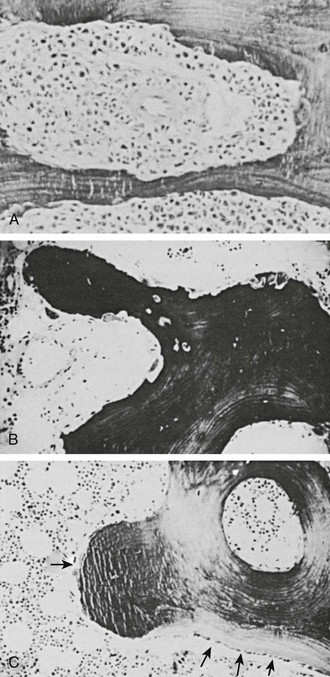
FIGURE 8-1 Bone biopsy photomicrographs. A, Local osteolytic hypercalcemia secondary to leukemia. Note the presence of leukemic cells in the marrow space and numerous osteoclasts lining the trabecular surface. B, Humoral hypercalcemia of malignancy caused by squamous carcinoma. Note the absence of tumor in the marrow space but the presence of numerous active osteoclasts on the trabecular surface. Also note the absence of osteoblasts and osteoid. C, Hyperparathyroidism. Note the abundant osteoclasts, osteoblasts, and osteoid. Osteoblasts are indicated by small arrows, and osteoblasts by large arrows. (B and C from Stewart AF, Vignery A, Silverate A, et al: Quantitative bone histomorphometry in humoral hypercalcemia of malignancy: uncoupling of bone cell activity, J Clin Endocrinol Metab 55:219–227, 1982.)
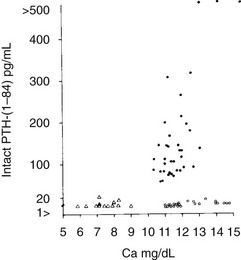
FIGURE 8-2 Immunoreactive parathyroid hormone in the serum of patients with primary hyperparathyroidism (solid circles), hypoparathyroidism (triangles), and hypercalcemia of malignancy (open circles) as measured with a two-site immunoradiometric assay for parathyroid hormone (1-84). Note the clear separation of patients with hyperparathyroidism from those with malignancy-associated hypercalcemia. (Data from Nussbaum SR, Zahradnik RJ, Lavigne JR, et al: Highly sensitive two-site immunoradiometric assay of parathyrin and its clinical utility in evaluating patients with hypercalcemia, Clin Chem 33:1364–1366, 1987.)
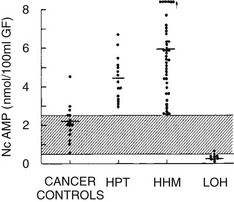
FIGURE 8-3 Nephrogenous cyclic adenosine monophosphate excretion in patients with normocalcemia and cancer (cancer controls), primary hyperparathyroidism (HPT), humoral hypercalcemia of malignancy (HHM), and local osteolytic hypercalcemia (LOH). (Data from Stewart AF, Horst R, Deftos LJ, et al: Biochemical evaluation of patients with cancer-associated hypercalcemia: evidence for humoral and non-humoral groups, N Engl J Med 303:1377–1383, 1980.)
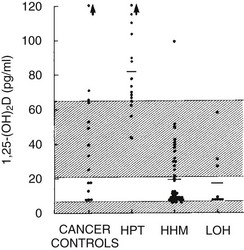
FIGURE 8-4 Plasma 1,25-dihydroxyvitamin D concentration in the four groups described in Figure 8-3. (Data from Stewart AF, Horst R, Deftos LJ, et al: Biochemical evaluation of patients with cancer-associated hypercalcemia: evidence for humoral and non-humoral groups, N Engl J Med 303:1377–1383, 1980.)

FIGURE 8-5 Immunoreactive parathyroid hormone–related protein (PTHrP) in plasma from patients with the clinical syndromes listed below the x-axis. Note that patients with humoral hypercalcemia of malignancy (HHM) have elevated circulating PTHrP concentrations. (Data from Burtis WJ, Brady TG, Orloff JJ, et al: Immunochemical characterization of circulating parathyroid hormone-related protein in patients with humoral hypercalcemia of malignancy, N Engl J Med 322:1106–1112, 1990.)
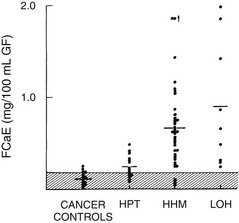
FIGURE 8-6 Fasting calcium excretion in the four groups described in Figure 8-3. Note that on average, patients with humoral hypercalcemia of malignancy (HHM) and local osteolytic hypercalcemia (LOH) appear to be more calciuric than do patients with primary hyperparathyroidism (HPT). Compare these findings with those in Figure 8-8. (Data from Stewart AF, Horst R, Deftos LJ, et al: Biochemical evaluation of patients with cancer-associated hypercalcemia: evidence for humoral and non-humoral groups, N Engl J Med 303:1377–1383, 1980.)
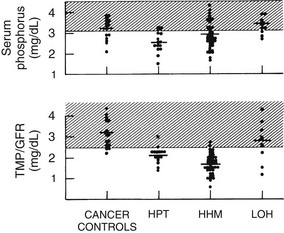
FIGURE 8-7 Serum phosphorus and renal phosphorus threshold in the four groups described in Figure 8-3. (Data from Stewart AF, Horst R, Deftos LJ, et al: Biochemical evaluation of patients with cancer-associated hypercalcemia: evidence for humoral and non-humoral groups, N Engl J Med 303:1377–1383, 1980.)
Humoral Hypercalcemia of Malignancy
Humoral hypercalcemia of malignancy (HHM) accounts for approximately 80% of patients in unselected series of individuals with MAHC.2–12,17–22 Approximately 50% of patients with HHM have an underlying squamous carcinoma of the lung, cervix, esophagus, larynx, oropharynx, vulva, skin, or other site2–12,17–22 (see Table 8-1). Carcinomas of the kidney, ovary, and bladder also are very common.2–14,19–22 It is interesting to note that breast cancer not only may cause MAHC through LOH and skeletal metastases but also may cause hypercalcemia in the absence of skeletal metastases in a classic HHM scenario43,44 (see Table 8-1). Human T cell lymphoma/leukemia virus-I lymphomas, 90% of which are associated with hypercalcemia, also operate through this mechanism.45,46 Finally, hypercalcemia resulting from endocrine tumors such as pheochromocytomas47,48 and islet cell carcinomas49,50 may cause hypercalcemia through this mechanism. As is the case with LOH, virtually every tumor type has been reported on occasion to cause HHM. It is interesting to note that not every tumor that causes hypercalcemia is malignant. Examples of systemic secretion of PTHrP by benign neoplasms (mammary hypertrophy and uterine leiomyomas are examples) have been reported to cause “humoral hypercalcemia of benignancy.”51
Since the advent of Albright’s humoral theory of hypercalcemia of malignancy in the 1940s,3 several substances have been proposed as candidates for the humoral mediator responsible for HHM. In the 1960s, Gordan and coworkers52 suggested that elevated circulating levels of four phytosterols (plant-derived vitamin D analogues) were present in patients with breast carcinoma. Subsequent studies showed, however, that these same phytosterols were present in equivalent concentrations in normal and lactating women, and that the potency of these analogues was inadequate to cause hypercalcemia.53 The phytosterol theory thus lost support.
With the discovery in the 1970s that prostaglandin E2 (PGE2) was a potent stimulator of bone resorption both in tissue culture54 and in experimental animals in vivo,55 the possibility arose that the hypercalcemia associated with HHM was due to systemic PGE2 secretion by tumors. Seyberth and colleagues56 and others reported that urinary metabolites of PGE2 were elevated in patients with MAHC, and that therapy with prostaglandin synthesis inhibitors (aspirin, indomethacin) reversed the hypercalcemia in several patients. However, subsequent, more extensive studies have not shown frequent responses to indomethacin.57 It is the current view of most investigators that PGE2 does not act as a systemic mediator of bone resorption in most cases of HHM, and that therapy with prostaglandin synthesis inhibitors is usually ineffective. It should be clear, however, that these observations do not exclude a role for PGE2 or other arachidonate metabolites in HHM at the local level within the skeleton.
As was noted earlier, Albright3 initially had suggested that PTH was the responsible humoral factor. This concept subsequently gained wide acceptance, as evidenced by the entrance into common usage in the 1960s and 1970s of the terms “ectopic hyperparathyroidism” and “pseudohyperparathyroidism.”6 Evidence in support of the “ectopic PTH” thesis included (1) the humoral nature of the syndrome4,5,10; (2) the hypophosphatemia and renal phosphate–wasting characteristic of the syndrome; and (3) the apparent failure of suppression of PTH observed in the early generations of PTH radioimmunoassays.58,59 It is now clear, as is described later, that although bona fide ectopic hyperparathyroidism does indeed exist (see later), it is extremely rare and fails to account for most instances of HHM.
Today, it is widely accepted that the vast majority of cases of HHM are due to the secretion of PTHrP by tumors. Evidence for this statement can be summarized as follows: (1) tumors associated with HHM produce and secrete PTHrP, which leads to elevated circulating concentrations of PTHrP19–22 (see Fig. 8-5); (2) PTHrP infusion into laboratory animals and humans reproduces the key features of the HHM syndrome in vivo60–65; and (3) infusion of neutralizing antisera against PTHrP reverses the HHM syndrome in laboratory animal models.66,67







